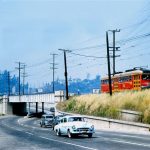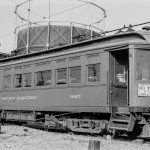Los Angeles & Pacific to Santa Monica Tickets
The Los Angeles Pacific Railroad was both a steam locomotive railway as well as an electric railway. It began in 1899 when “General” Moses Sherman and Eli P. Clark filed articles of incorporation. Clark would serve as president and a facsimile of his signature is on the top ticket. On June 16, 1903, the Los Angeles Pacific Railroad merged with the Los Angeles-Santa Monica Railroad Company and the Los Angeles, Hermosa Beach and Redondo Railway Company. The new name after this merger was the Los Angeles Pacific Railroad of California, but everyone still just called it the Los Angeles Pacific Railroad. The Los Angeles-Santa Monica Railroad Company was incorporated on December 2, 1902.
Over time there would be nearly 200 miles of track from the beach communities of the South Bay, including Redondo, Hermosa, Manhattan, El Segundo, Playa del Rey and Santa Monica. The lines headed eastward from the beach through the west side of Los Angeles, downtown Los Angeles, Sawtelle (The Soldier’s Home) and even through to Pasadena.
Rolling stock, in the heyday of 1906, included more than 400 pieces broken down as follows: 221 freight cars, 144 passenger cars, 17 electric locomotives, 12 repair service cars, 6 parlor cars and 5 mail cars.
From Terry Salmans: According to Interurbans Special 63 “Trolleys to the Surf” by Myers and Swett, LAP was sold to the Southern Pacific Railroad in 1906. The Los Angeles Pacific would be merged into the Pacific Electric in 1911.
By 1911 the PE could discontinue use of the steam locomotive lines, but continue to haul freight for decades.
Top ticket undated, blank on reverse. Bottom ticket back-dated 1908.
Michael Patris Collection





1906 Letter from May Rindge to Western Pacific Railway Company San Francisco expressing her wish to sell the Heuneme-Port Los Angeles railway right of way with her concerns about Sherman & Clark having designs on building north (through a Santa Monica Canon Railway shell): https://adamsonhouse.pastperfectonline.com/photo/0F4D9F3C-91C4-46F9-BB58-769020310160
Abandonment of the Rindge line, opening of the Malibu colony, and loss of the Malibu Pottery would all occur during the lifetime of the LAP lines under their future owner, Pacific Electric. PE lines would never go beyond the Long Wharf of the defunct Port Los Angeles. But LAP would open up Hollywood where, a few years in the future, so many movie people would get a career allowing them to populate Malibu and move out of Hollywood.
Of interest in this odd Santa Monica Canon Railroad reference, an earlier (1893) Congressional look into the ports & wharves of Southern California raised questions about what properties were owned by Southern Pacific et. al. and whether another railroad could run down the “canon” and cross the Espee tracks: https://books.google.com/books?id=2X43AQAAIAAJ&pg=RA18-PA53&lpg=RA18-PA53&dq=santa+monica+canon+railroad&source=bl&ots=AzLjBG6xog&sig=ACfU3U0F-iD1N9EiyCtfA_9yuvvsRoDxsQ&hl=en&sa=X&ved=2ahUKEwiXoNbM9fLkAhXFs54KHXntCC4Q6AEwEnoECAkQAQ#v=onepage&q=santa%20monica%20canon%20railroad&f=false
With the 1906 Southern Pacific buyout of Los Angeles-Pacific, one has to wonder what Sherman & Clark were actually up to in this Malibu route mess. And might they have been acting in the interest of Huntington or Harriman, or working against them?
An on-line check of the contents of Sherman’s surviving papers shows no listed mention of such a Canon Railroad charter which May Rindge alleged to have existed (and apparently viewed). There is but one reference to a Mrs. Rindge in a file folder dated for 1909 (far into the contents list). It should be noted that Sherman was long related to a Southern Pacific family via his marriage, and that additionally Clark was his brother in law. A quick look at the many Westside players tied into these two gentlemen reveals the close relationship of common companies and the ever present shadow of Southern Pacific and its’ extensive land holdings: https://books.google.com/books?id=sh-NCQAAQBAJ&pg=PT31&lpg=PT31&dq=sherman+%26+clark's+santa+monica+canon+railroad+company&source=bl&ots=Hw2eSoK2zb&sig=ACfU3U0bKqmfn8jm-EcM5ZYi3sk0ES_xuA&hl=en&sa=X&ved=2ahUKEwiN6bK6ifPkAhUTJjQIHazdBZQ4ChDoATAEegQICRAB#v=onepage&q=sherman%20%26%20clark's%20santa%20monica%20canon%20railroad%20company&f=false
It is commonly viewed that many of the “builders” of Southern California were merely venturesome capitalists in their own right. However, it might be time to look closer and see if they were an annointed few acting out the role of straw men for the financial interests behind some very large major railroad organizations. The true history of Pacific Electric and predecessors might hold far more than we have expected. Of course, an awful lot of paperwork was destroyed in the past, but there might still be traces to piece together a fuller story. Don’t shoot me, I’m only the messenger. Someone else rigged this.
Of another interesting note, practically no source on the Los Angeles-Pacific notes that this company was in control of a large part of the Jones-Baker Ranch property. But this 1904 electric railway news reveals it in discussing the plans for extensions along the bluffs and completion of the greater electric loop: https://books.google.com/books?id=YudI8dkNSOcC&pg=PA614&lpg=PA614&dq=corporations+santa+monica+canon+railroad+1905&source=bl&ots=va3J55r1jq&sig=ACfU3U26_CrGwuh1zGXGL7SjC976ZUeCyw&hl=en&sa=X&ved=2ahUKEwio55f3mvPkAhVKnJ4KHeNUDPI4ChDoATAGegQICRAB#v=onepage&q=corporations%20santa%20monica%20canon%20railroad%201905&f=false
To be sure, Southern Pacific had turned over their Long Wharf line to LA-P and had already focused on chopping up Chatsworth Park for rocks to open the new port facilities in San Pedro. Further completing the Chatsworth coastal cut-off through the Santa Susanna grade, Espee now left the Rindge-owned Malibu ranch as the last large estate of the Spanish era in the position of isolation. Failing to gain rights of way over that land (and they had tried), Sherman and Clark might have been just what was needed to drive a wedge under the immovable boulders that resided there. (Mr. Rindge had been one of the investment partners down in the Playa del Rey lands. Did he get burned?) The cost of two decades of fighting would strip the family resources and ensure the break-up of the property while keeping out any other troublesome rail ventures (even Santa Fe had largely backed out on the south side of the territory). By the time an interjected county road became a state highway, Espee had largely lost interest in the declining revenues of local passenger transport but was making money on shipping all those new automobiles and parts.
Unable to find any trace of this Canon Railroad so far, this 1912 related post shows a map of the subdivision of the lower canyon where Sherman & Clark would have (up to c.1904-6) had to meet the Espee/PE line below the Long Wharf in order to project any extension northward. The mentioned Santa Monica Land Company in control of the canyon is also known as the Santa Monica Land and Water Company (in the hands of the usual suspects) which seems to correspond to that same group of ranch property that LA-P was reported to be in control of: https://homesteadmuseum.wordpress.com/2017/08/25/all-over-the-map-santa-monica-canon-subdivision-1912/
At the upper canyon, any new railroad would have run into the SM-Hollywood-LA line of LA-P, now controlled by Harriman’s Espee and later merged into New PE (1911). If this followed some of the observed practices related to Espee aquisitions of new lines, then Sherman and Clark might have ended up ultimately transferring the whole shebang to control of the Kentucky corporation under the pretense of financial problems. And Pacific Electric would have have a whole new line heading toward San Francisco!
If all the above seems rather hard to fathom, try this…as far back as the Pacific Railroad Surveys, botany lithos illustrated tree species such as the so-called “Picea Grandis” (Plate VI 1857) under which are a couple of surveyors sitting on a felled log…the point made of how plentiful lumber was going to be a key component of this undertaking. Mr. Clark was reported to have been in the lumber business at the point where he suddenly jumped into becoming a railroad builder around Prescott in the Arizona Territory. Oddly enough, an investigation into an old shovel whose markings were not an exact match for Western Pacific Railroad may have revealed the excessively close relationship with Southern Pacific of two more celebrated nabobs known as Wendling and Johnson. Basically, they used lumber mills (and box factories and so on) to build short lines that conveniently seem to end up in the hands of Espee. All of this went on in Northern California and Oregon with companies operated out of San Francisco, but possibly set up as Nevada corporations before that state tightened it’s laws. Special attention might be paid to the banks that were usually backing these ventures. It would seem that this game was hardly isolated to one region. A link to Q3362 at Railroadiana (see also Q3663): http://railroadiana.org/pgQB.php